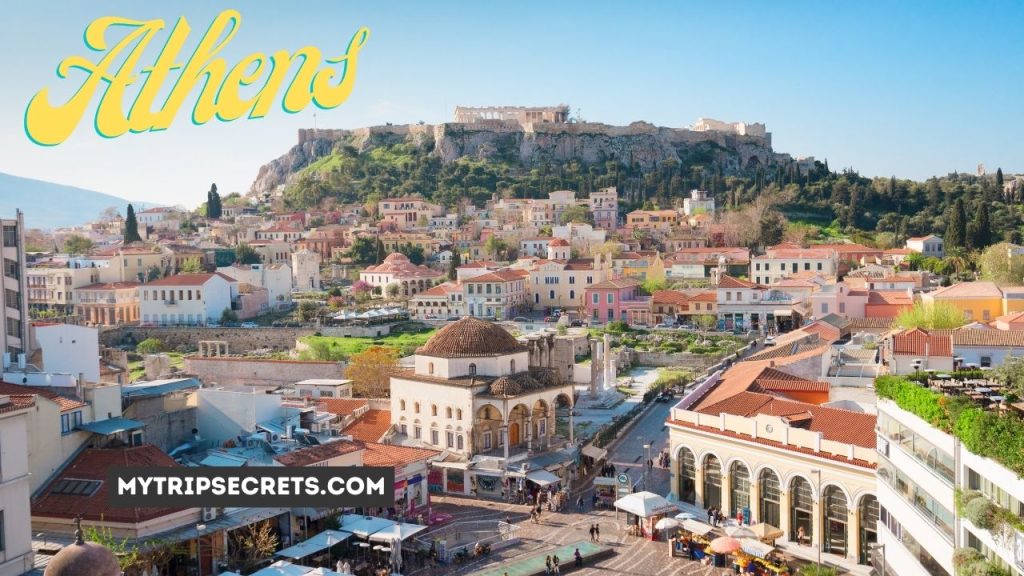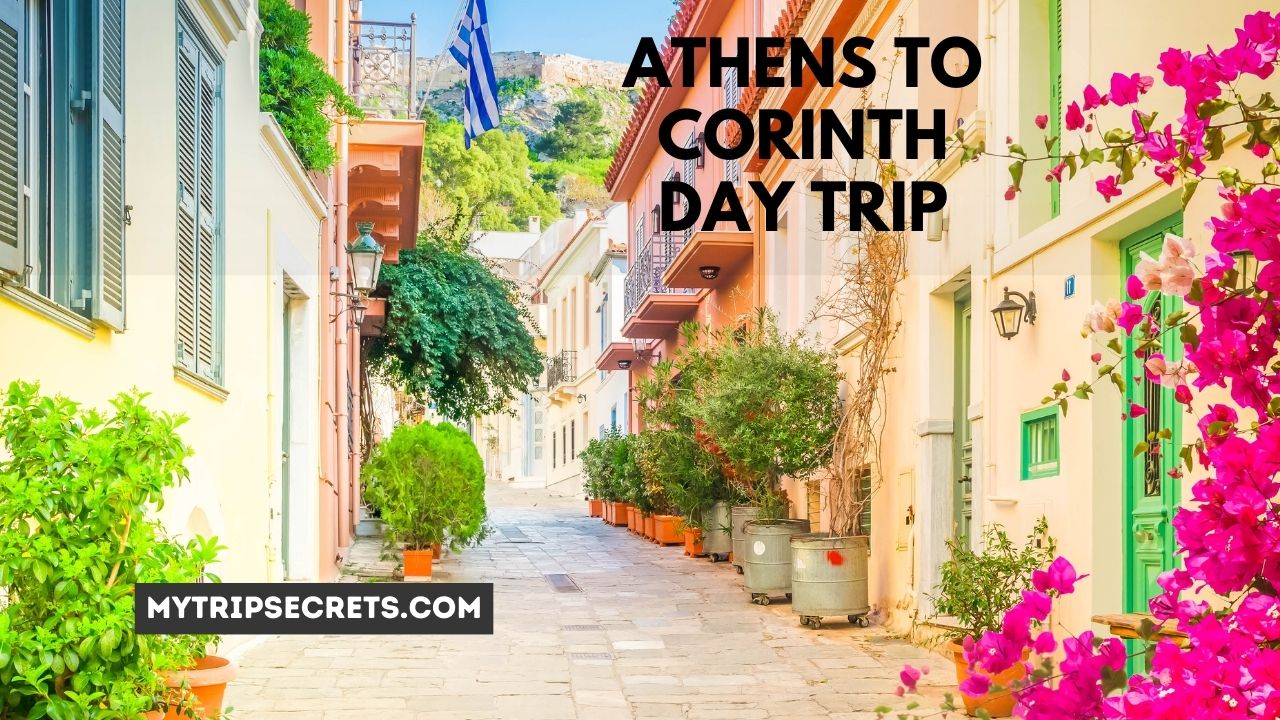Greece is a country with a long and storied history spanning over 3,000 years. From the myths of ancient gods and heroes to the rise and fall of powerful city-states and empires, Greece has an endless wealth of mesmerizing tales to tell. Two cities that perfectly encapsulate this rich history are Athens and Corinth. While Athens represents the glory days of ancient Greece with its magnificent Acropolis and groundbreaking philosophers, Corinth provides a window into ancient myths and trade. Taking a day trip from Athens to Corinth allows you to immerse yourself in these captivating stories as you walk amongst historic ruins and artifacts.
Contents
- 1 Athens to Corinth Day Trip
- 2 Sightseeing Itinerary and Timing
- 3 Top Things to See and Do
- 4 10 Travel Tips for Athens to Corinth Day Trip
- 5 Frequently Asked Questions
- 5.1 How long does it take to travel between Athens and Corinth?
- 5.2 Should I visit Corinth and the Canal on separate days?
- 5.3 Can I see Acrocorinth and Ancient Corinth on the same day?
- 5.4 When is the best time of year to visit Corinth from Athens?
- 5.5 What type of footwear is best for exploring Corinth sites all day?
- 6 Plan Your Visit
Athens to Corinth Day Trip
Corinth lies about 50 miles southwest of Athens, making it an easy and popular day trip. There are a few transportation options to get you between these two historical cities.
By Organized Tour
The most effortless way to travel is booking a guided day tour from Athens to Corinth. Reputable tour companies such as CitySightseeing Athens, Key Tours, and Greek Travel offer full-day excursions complete with air-conditioned coach buses and expert guides. Most tours start early in the morning and make several stops including the Corinth Canal, Acrocorinth, the archeological site, and museum. Booking a tour takes the hassle out of navigating on your own.
| Tour Company | Price | Duration |
|---|---|---|
| CitySightseeing Athens | $80 | 8 hours |
| Key Tours | $95 | 10 hours |
| Greek Travel | $105 | 10 hours |
DIY with Public Buses
You can also opt to take public transportation from Athens to Corinth on your own without a formal excursion. KTEL buses depart daily from Athens’ Mavromateon Terminal to Corinth’s modern bus station, the journey takes between 1.5 to 2 hours each way. The total cost of a return bus ticket is around $25. While cheaper, keep in mind bus schedules are limited so you’ll have less time flexibility for sightseeing on your own.
Rental Car
Renting a car offers the greatest level of independence and flexibility to explore Ancient Corinth and surrounding areas at your own pace. The drive from Athens to Corinth via toll roads takes just under an hour. Major rental companies like Budget, Hertz, Sixt, and Enterprise have locations across Athens. Rental car rates start around $30 per day. Having your own transportation allows you to customize your itinerary and visit neighboring towns as well.
Sightseeing Itinerary and Timing
Regardless of how you get there, it’s wise to have an efficient sightseeing strategy planned out with opening and closing times in mind. Here is a recommended 10 to 12 hour itinerary to experience the best of Corinth in a day from Athens:
Morning (Approximately 4 hours total)
8 AM: Arrive to Corinth Area
8:30-10:30 AM: Explore Ancient Corinth Ruins – Allow 2 hours to walk through the expansive archaeological site with the Temple of Apollo, theater, agora, fountains, temples and more.
10:45 AM-12:15 PM: Corinth Museum – Admire artifacts like statues, pottery, coins and jewelry found amongst the Corinth ruins. 45 to 60 minutes is sufficient here.
12:30 PM: Break for Lunch – Enjoy local Greek cuisine at one of the many tavernas near the museum.
Afternoon/Evening (Approximately 6-8 hours)
2:30 PM: Drive or taxi to Corinth Canal – Walk along the scenic canal connecting the Aegean Sea to the Ionian Sea, this takes 30-45 minutes.
4 PM: Explore Acrocorinth Medieval Fortress – Allow 2 to 3 hours to climb up and roam around these impressive defensive walls and structures with panoramic views.
6:30 PM: Wander through Loutraki seaside resort town – Take an hour to stroll along the beach boardwalk and get dinner.
8 PM: Return to Athens or stay overnight in Corinth area
This covers the top sites and experience, but you can adjust the schedule to your interests. For example, you can start later and focus only on Acrocorinth Fortress in the afternoon/evening if less sightseeing time.
Top Things to See and Do
Once you arrive in Corinth, there is an abundance of ancient ruins, artifacts, myths, and natural beauty to uncover across this region.
Marvel at Ancient Corinth Ruins
The premier attraction is the ruins of ancient Corinth situated right next to the modern town. Dating back to the 8th century BC, this was once a large bustling city-state and prominent trading center under rulers like Periander. Excavations starting in the late 19th century have uncovered many structural remains like statues, temples, fountains, shops etc. that give a glimpse into what life was like thousands of years ago.
Some key ancient Corinth highlights and photo ops include:
- The Temple of Apollo: Originally built in 550 BC, seven standing Doric columns have been restored here along with partial foundations outlining the perimeter of the temple. It once housed a giant golden statue of Apollo.
- The Fountain of Peirene: This elaborately decorated stone fountain was an integral water source for the city and mythological, tied to stories of goddess Peirene.
- Lechaion Road: This stone road led travelers and merchants to the nearby ports like Lechaion on Corinthian Gulf, walk a section seeing wheel ruts.
- Glauke Fountain: Named for a mythical Corinthian princess, this circular Roman fountain has four reclining lion heads with water spouts.
- The Bema: A 7 meter tall stone platform where nobility would speak to citizens below on important matters. The Apostle Paul famously testified here.
- Temple of Octavia: Originally a Roman temple built in the 2nd century AD honoring Emperor Augustus’ sister Octavia. You can still see six of the original Corinthian columns today.
Wandering through this sprawling site with ruins dotting olive groves transports you back in time to imagine what life was like at the height of its prosperity.
Admire Artifacts at the Corinth Museum
After exploring the excavated ruins, a visit to the nearby Archaeological Museum of Ancient Corinth provides even more color and context. Only a five minute walk north of the site, this smaller museum houses the most interesting artifacts like statues, jewelry, coins, and pottery found amongst the Corinth ruins spanning from the Classical, Hellenistic, and Roman periods in chronological order.
Some of the museum’s highlights include:
- Athena Torso Statue
- Apollo Klarios Statue Head
- Hermes Statuette
- Terracotta Figurines
- Grave Goods
- Mosaics
- Temple Frieze Fragments
- Christian Sarcophagi
- Votive Offerings
- Oil Lamps
- Tools
- Byzantine column capitals
Not only are the items fascinating to admire, but placards also weave in the mythological stories and historical figures tied to the relics making them come alive. With the sheer quantity and quality of artifacts found, you can easily spend an hour visiting the museum to place the ruins into more context.
Be in Awe at the Corinth Canal
While the Corinth Canal is technically in a town called Isthmia just outside Corinth, it’s still considered one of the top attractions in the broader region. This unique 6 kilometer canal connects the Gulf of Corinth (part of the Ionian Sea) to the Saronic Gulf (part of Aegean Sea) allowing ships to shortcut through the narrow Isthmus of Corinth rather than sail around the entire Peloponnese peninsula.
Started in 1881 and completed in 1893 by thousands of laborers, the canal reaches 79 feet in width at sea level. The tall limestone rock walls tower 300 feet above making it an awe-inspiring engineering marvel. Visitors can walk across the road bridge spanning the canal to enjoy panoramic views of the canal with ships slowly passing through the managed locks and small Loutraki harbor on the other side. There are also restaurants like Canalis Tavern and lookout plaza to take stunning photos at this manmade wonder.
Hike the Acrocorinth Medieval Fortress
Sitting atop a tall limestone rock outcrop overlooking ancient Corinth are the impressive fortified ruins of Acrocorinth. The ruins visible today mostly date to medieval Byzantine and Frankish eras spanning the 13th to 15th centuries AD but fortifications existed on and off as early as the 5th century BC. This strongly positioned castle provided strategic defense for various rulers over the centuries.
The most stunning highlight is hiking to the Upper Citadel through the rough past the imposing south gate and turrets. Climb through narrow tunnels and steep steps to the highest point at 633 feet taking in sprawling views of village rooftops dotted with Byzantine churches below and the wide blue Corinthia plains stretching to the distance. The ruins themselves across multiple terraces feature intricate Gothic gates, crumbling towers, sheer defensive walls, chapels, temples, mosques, reservoirs, shops and residential quarters. Expect to spend at least 2 to 3 hours fully exploring Acrocorinth’s nooks and crannies while soaking in the sweeping views overlooking the ancient site below.
Relax in Loutraki Seaside Town
After a full day exploring Corinth’s ancient history, take time to relax along the beach boardwalk in the quaint seaside village of Loutraki just a few miles from the canal. Known for its vast Blue Flag beaches, mineral water springs, and seaside promenade dotted with tavernas and cafes, Loutraki has been a popular spa destination since Roman times.
Take a dip in the therapeutic springs at Loutraki Thermal Spa, then stroll the palm-lined beach walkway as you watch the sunset behind the waves while getting dinner at a local Greek restaurant. It’s the perfect laidback way to cap off your jam-packed day trip immersion into Corinthian history and culture before heading back to Athens fully recharged. With its endless historical sites, delicious cuisine, quaint villages, impressive natural landscapes from azure seas to imposing mountains, Corinth makes for an unforgettable day trip adventure from Athens no history buff will want to miss!
10 Travel Tips for Athens to Corinth Day Trip

-
Book an organized group tour to maximize sightseeing efficiency and minimize transportation logistics.
-
Travel early in the morning to give yourself enough time to see all the top attractions.
-
Wear comfortable walking shoes as you’ll be on your feet all day exploring archaeological ruins.
-
Stay hydrated and pack snacks, lunch, water as food options are limited near some sites.
-
Purchase a combined ticket to access ancient Corinth ruins and museum to save money.
-
Take the Acrocorinth fortress hike slowly and carefully as steep parts lack handrails.
-
Don’t skip the Corinth Canal, the towering limestone cliffs slicing through sea are breathtaking.
-
Capture plenty of photos but balance sightseeing time wisely at each stop.
-
Read up on Greek mythology tied to Corinth to better understand site backgrounds.
-
End your day relaxing seaside at a Loutraki village cafe or taverna along the boardwalk.
Frequently Asked Questions
How long does it take to travel between Athens and Corinth?
The travel time between Athens and Corinth ranges from 1 to 1.5 hours depending on mode of transportation:
- Organized tour bus: Around 1.5 hours
- Public bus: Around 2 hours
- Rental car via toll roads: 1 hour
So be sure to account for a good chunk of transit time when planning your day trip itinerary.
Should I visit Corinth and the Canal on separate days?
No, Corinth sites and the canal can comfortably be seen in one full day trip from Athens. However, you can choose to also spend a night in the area to have more flexibility for sightseeing, relaxation or to visit nearby villages like Loutraki. Many organized tours include an overnight option as well.
Can I see Acrocorinth and Ancient Corinth on the same day?
Yes! Acrocorinth fortress ruins and Ancient Corinth archaeological site are just a few miles from each other making it easy to visit both in the same day. Just be sure to tour Ancient Corinth first before tackling the uphill Acrocorinth hike.
When is the best time of year to visit Corinth from Athens?
Spring and fall are ideal times with comfortable temperatures, fewer crowds, lush greenery and pop of wildflowers. April-May and September-October tend to have mild weather without excessive heat or rain during these shoulder seasons. Travel in the hot summer is still feasible however if visiting ancient sites in earlier cooler parts of day.
What type of footwear is best for exploring Corinth sites all day?
Wear supportive sneakers or strappy sandals suitable for extensive walking over ancient ruins and climbing uphill. Have proper non-slip footwear for Acrocorinth fortress with steep sections and rocky areas. Bring an extra pair of flip-flops or sandals for post hike relaxation.
Plan Your Visit
Corinth offers enough incredible history and scenery to keep you mesmerized all day long on an easy day trip from Athens. With a strategically planned itinerary and mix of independent exploration or convenient guided tours, you’re bound to have an unforgettable Greek adventure spanning ancient myths to medieval castles and scenic seaside villages.
Immerse yourself on location treading the same paths as Greek legends and merchants that shaped Corinth to become the storied metropolis it remains today. Let their epic tales come alive through Every statue, temple, artifact, fortress view, and lapping wave adding dynamic texture to enhance your understanding of Greek’s incredible past.
Whether you’re a history buff, ruin junkie, museum nerd, or nature lover there’s something inspiring in Corinth for everyone beckoning to be discovered!

